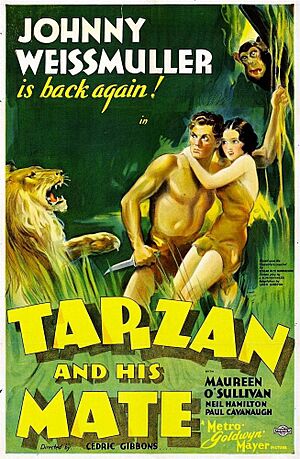Cedric Gibbons facts for kids
Quick facts for kids
Cedric Gibbons
|
|
|---|---|

Gibbons in 1936
|
|
| Born |
Austin Cedric Gibbons
March 23, 1890 New York City, U.S.
|
| Died | July 26, 1960 (aged 70) Los Angeles, California, U.S.
|
| Resting place | Calvary Cemetery, East Los Angeles |
| Occupation |
|
| Years active | 1919–1956 |
| Spouse(s) | |
| Relatives |
|
Austin Cedric Gibbons (born March 23, 1890 – died July 26, 1960) was an American art director for movies. He also helped design many movie theaters from the 1930s to the 1950s. Gibbons designed the famous Oscar statuette in 1928. He asked artist George Stanley to sculpt it. Gibbons was nominated 39 times for the Academy Award for Best Production Design and won 11 Oscars. Both of these are records!
Contents
Early Life
Cedric Gibbons was born in New York City in 1890. His father, Austin P. Gibbons, was an architect. Cedric studied at the Art Students League of New York in 1911. He started working in his father's office as a junior draftsman.
Later, in 1915, he joined the art department at Edison Studios in New Jersey. During World War I, he served in the US Navy Reserves.
Career in Film
Gibbons joined Goldwyn Studios. In 1924, he began a long career with Metro-Goldwyn-Mayer (MGM) when the studio was founded.
Designing for MGM
In 1925, Gibbons worked in the art department at MGM. He competed for a higher position. He used his knowledge of a new style called art deco (then known as art moderne). This helped him move up in the MGM art department. He worked on the movie Ben Hur (1925).
Creating the Oscar Statuette
Gibbons was one of the first 36 people to start The Academy of Motion Picture Arts and Sciences. He designed the Academy Awards statuette in 1928. This is the famous Oscar trophy. He himself was nominated for an Oscar 39 times. He won 11 times for Best Art Direction. His last win was for Somebody Up There Likes Me (1956).
He retired from MGM on April 26, 1956. He was the head of the art department. He had worked on over 1,500 films. Many other designers also worked on these films. But Gibbons' own work and contributions were very important and long-lasting.
Personal Life
In 1926, Gibbons married Gwendolyn Weller. They divorced a short time later.
In 1930, Gibbons married actress Dolores del Río. They designed their house together in Santa Monica. It was an Art Deco style home. They divorced in 1941. In October 1944, he married actress Hazel Brooks. They stayed married until his death.
Cedric Gibbons had a niece named Veronica "Rocky" Balfe. She was married to the famous actor Gary Cooper. Gibbons' second cousin, Frederick "Royal" Gibbons, was a musician. He worked with Cedric at MGM. Frederick was the father of Billy Gibbons from the rock band ZZ Top.
Even though he was born in New York, Gibbons sometimes said he was born in Ireland. The reason for this is not known.
Death and Legacy
Gibbons died in Los Angeles on July 26, 1960. He was 70 years old. He was buried at the Calvary Cemetery, East Los Angeles.
Influence on Architecture
Gibbons' designs for movie sets inspired how movie theaters were built. This was especially true from the late 1930s to the 1950s. His style is sometimes called Art Deco or Art Moderne. You can still see this style in theaters like the Loma Theater in San Diego.
Lasting Impact
The iconic Oscar statuettes that Gibbons designed are still given out today. They are presented to winners at the Academy Awards ceremonies every year.
In February 2005, Gibbons was honored. He was inducted into the Art Directors Guild Hall of Fame.
Academy Awards
Awards for Art Direction
- The Bridge of San Luis Rey (1929)
- The Merry Widow (1934)
- Pride and Prejudice (1940)
- Blossoms in the Dust (1941)
- Gaslight (1944)
- The Yearling (1946)
- Little Women (1949)
- An American in Paris (1951)
- The Bad and the Beautiful (1952)
- Julius Caesar (1953)
- Somebody Up There Likes Me (1956)
Nominations for Art Direction
- When Ladies Meet (1933)
- Romeo and Juliet (1936)
- The Great Ziegfeld (1936)
- Conquest (1937)
- Marie Antoinette (1938)
- The Wizard of Oz (1939)
- Bitter Sweet (1940)
- When Ladies Meet (1941)
- Random Harvest (1942)
- Madame Curie (1943)
- Thousands Cheer (1943)
- Kismet (1944)
- National Velvet (1944)
- The Picture of Dorian Gray (1945)
- Madame Bovary (1949)
- The Red Danube (1949)
- Annie Get Your Gun (1950)
- Too Young to Kiss (1951)
- Quo Vadis (1951)
- The Merry Widow (1952)
- Lili (1953)
- The Story of Three Loves (1953)
- Young Bess (1953)
- Brigadoon (1954)
- Executive Suite (1954)
- I'll Cry Tomorrow (1955)
- Blackboard Jungle (1955)
- Lust for Life (1956)
See also
 In Spanish: Cedric Gibbons para niños
In Spanish: Cedric Gibbons para niños
- Art Directors Guild Hall of Fame


